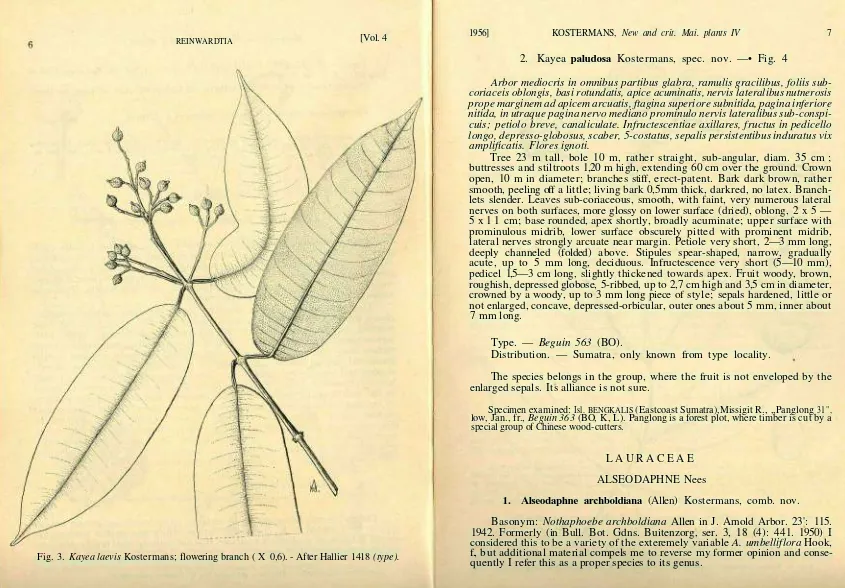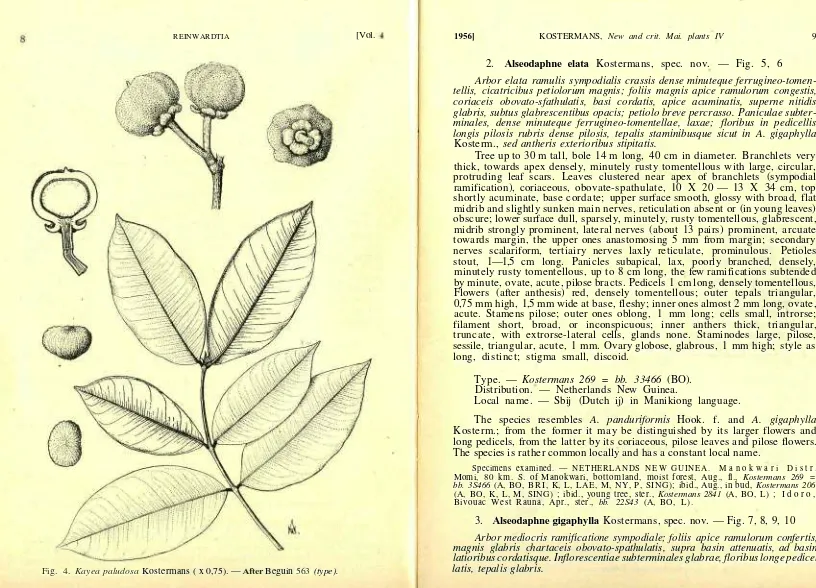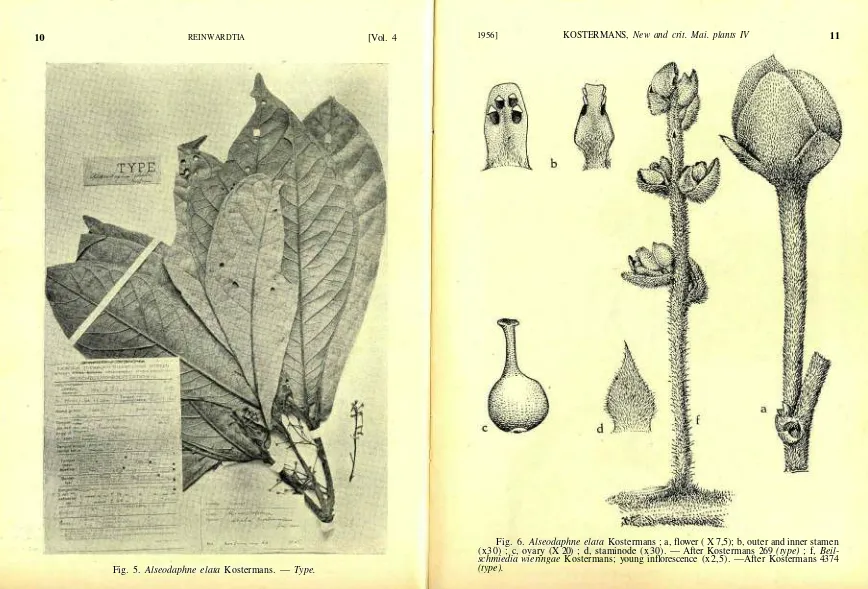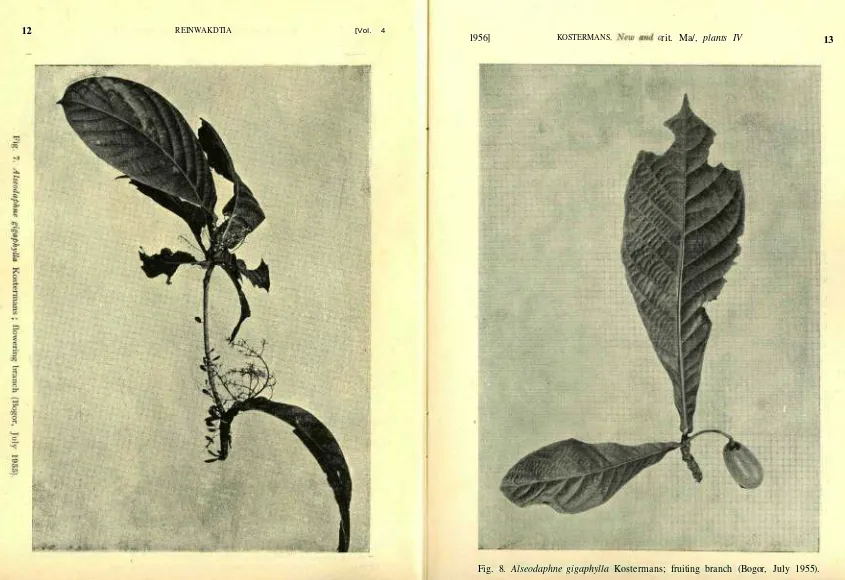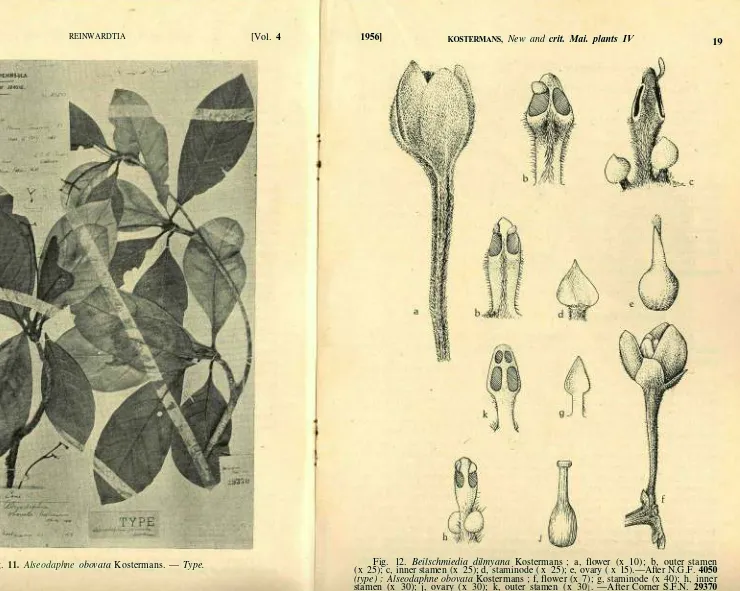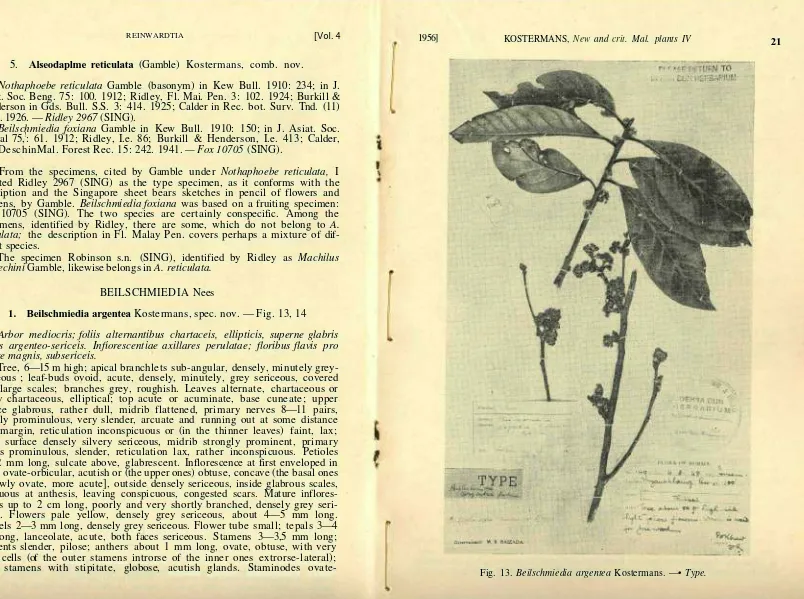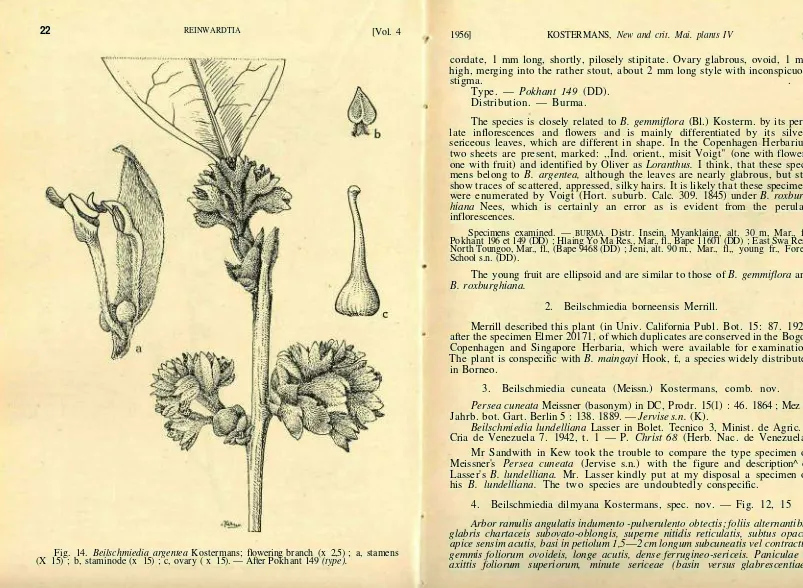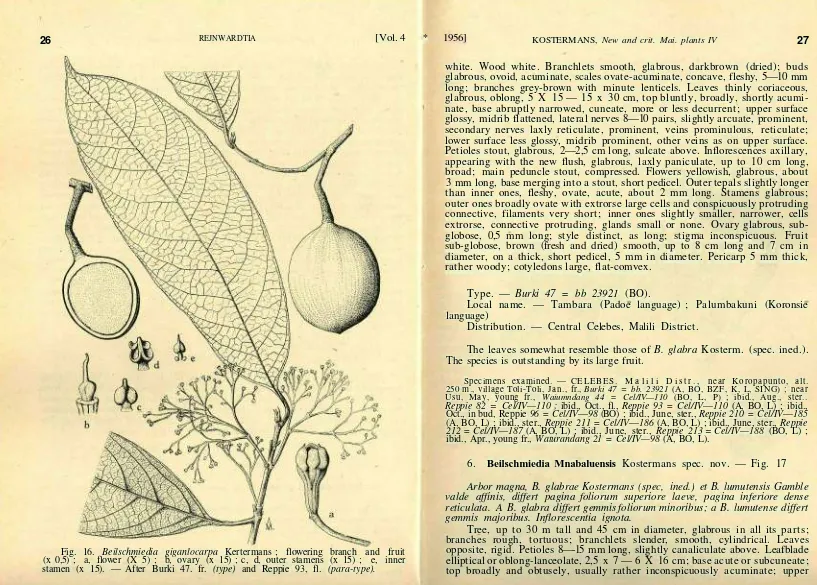VOLUME 4 DECEMBER 1956 PART i
REINWARDTIA
BEING A CONTINUATION OF THE
BULLETIN DU JARDIN BOTANIQUE DE BUITENZORG
(BULLETIN OF THE BOTANIC GARDENS, BUITENZORG)
EDITORS A N W A R I DILMY (Herbarium Bogoriense)
AND
C. G. G. J. VAN STEENIS (Flora Malesiana)
Published by
HERBARIUM BOGORIENSE
KEBUN RAYA INDONESIA
HERBARIUM BOGORIENSE
Keeper:
ANWARI DILMY,Lecturer in Taxonomy, Acting Director Academy
of Biology.
Staff :
-J.
VAN BORSSUM WAALKES,Botanist.
M.
JACOBS,Botanist.
Honorary collaborators:
Dr K. B.
BOEDUN,Professor, Faculties of Agriculture and Veterinary
Sciences, University of Indonesia.
Dr M. A. DONK, Leiden, Netherlands.
Dr A. J. G. H. KoSTERMANS, Forest Service of Indonesia.
REINWARDTIA
Published by Herbarium Bogoriense, Kebun Raya Indonesia Volume 4, part 1, pp. 1—40 (1956)
NEW AND CRITICAL MALAYSIAN PLANTS IV * **
A. J. G. H. KOSTERMANS *** Summary
1. Sixteen new species are described in
Guttiferae : Garcinia longipedicellata, G. segmentata; Kayea laevis, K. paludosa. Lauraceae : Alseodaphne data, A. gigaphylla, A. obovata ; Beilschmiedia argentea, B. dilmyana, B. gigantocarpa, B. kinabaluensis, B. myrmecophila, B. rufolanata, B. rufoperu-lata, B. wieringae ; Dehaasia novoguineensis.
2. Seven new combinations are coined in
Lauraceae : Alseodaphne archboldiana (Allen) (basonym : Nothaphoebe archboldiana Allen), A. reticulata (Gamble) (basonym : Nothaphoebe reticulata Gamble) ; Beilschmiedia cuneata (Meissn.) (basonym : Persea cuneata Meissn.) ; Beilschmiedia palembanica (Miq.) (basonym : Cryptocarya palembanica Miq ) ; Dehaasia longipedicellata (Ridley) (basonym : Beilschmiedia longipedicellata Ridley), D. oblanceolata (Merr.) (basonym : Beilschmiedia oblanceolata Merrill) ; D. titanophytta (Airy Shaw) (basonym : Beilschmiedia titanophylla Airy Shaw).
3. Two new names are coined in
Lauraceae : Dehaasia membranacea Kosterm. (based on Dehaasia longipedicellata (non Ridley) Merrill).
Sterculiaceae : Sterculia perryae Kosterm. (based on Sterculia clemensiae (non Ridley) Merr. & Perry).
4. Eight species are reduced to synonymy in
Lauraceae : Beilschmiedia borneensis Merrill = B. maingayi Hook, f., B. foxiana. Gamble = Alseodaphne reticulata (Gamble)'Kosterm., Beilschmiedia longipes Hook. f. — B. palembanica (Miq.) Kosterm., B. lundelliana Lasser = B. cuneata (Meissn.) Kosterm., B. sumatrensis Ridley = B. palembanica (Miq.) Kosterm., B. triplinervis Teschner = Cryptocarya laevigata Bl. ; Endiandra sphaerica Allen = Beilschmiedia novoguineensis Teschner.
Rosaceae : Polyalthia pulchrinervia Boerlage (Annonaceae) = Parinari corymbosa Miq.
G U T T I F E R A E
GARCINIA L.
1. Garcinia longipedicellata Kostermans, spec. nov. — Fig. 1
Arbor mediocris in omnibus partibus glabra ; foliis chartaceis in statu sicco virescentibus, oblongis, costis lateralibus gracilibus prominulis, petiolo conspicuo; floribus glomeratis et axiUaribus, perlonge pedicellatis.Tree, 7 m tall, glabrous in all its parts, with stiff, very patent branches; young branches cylindrical, thick; internodes 2—3 cm long. Leaves charta-ceous, dull, green when dried, oblong o r elliptic, 4 x 1 0 — 7 x 2 0 cm; top
* The first and second part of this series appeared in : Reinwardtia 2 : 357—366. 1953 and 3 : 1—25. 1954 respectively ; the third and fourth (this) part appeared se-parately, issued by the Planning Division of the Indonesian Forest Service in Febr. and Oct. 1955. This fourth partis exactly like the original publication of Oct. 1955. ** In this paper one plant from India : Beilschmiedia argentea Kosterm. and one from
South America : Beilschmiedia cuneata (Meissn.) Kosterm. are treated.
REINWARDTIA [Vol. 4
Fig. 2. Garcinia segmentata Kostermans; branch and inflorescences (xO,G); a, flower bud (X 3) ; b, female flower without petals (X 3) ; c, section of female flower (X 3) • d, fruit (X 0,6). — a-c after Reppie 523 (type), d, after bb. 20272 (para-type).
1956] KOSTERMANS, New and crit. Mai. plants IV
Type. — Repptt 523 = CeljV-296 (BO); para-type (fruiting): van Zijll de Jong 33/F.Z. = 'bb. 20272 (BO).
Distribution. — Celebes. Northern and western part of Gulf of Bone.
/ • •
The species is related to Garcinia rip aria A. C. Smith. ,
S p e c i m e n s e x a m i n e d . — C E L E B E S . M a l i l i D i s t r . , Toli-Toli. J a n . , fl., Reppie •
523 = Cell'V—296 (A, B O , L) ; R a n t e p a o D i s t r . , M a k a l e , P a n i k i , a l t . 900 m . ,
Febr., fi\, van Zijll de Jong 33/V.Z. = bb. 20272 (BO).
KAYEA Wall.
1. Kayea laevis Kostermans, spec. nov. — Fig. 3
Arbor in omnibus partibus glabra, ramulis cinereis gracilibus, foliis rigide coriaceis perdense minuteque areolatis (areolis in pagina superiore vix conspicuis) oblongis, basi rotundatis, apice longe acuminatis, nervis lateralibus distantibus gracillimis in pagina superiore vix conspicuis prope marginem incurvatis apicem versus arcuatis evanescentibus; petiolo distincto late canaliculato. Paniculae axittares subterminalesque laxae floribus subglobosis.
Tree, completely glabrous in all its parts; branchlets slender, angular, glossy, grey. Leaves rigid coriaceous, oblong, 5 x 15 — 7,5 x 22 cm; base rounded, top acuminate (acumen 1,5 cm long, rather slender); upper leaf-surface smooth or very obscurely pitted, midrib slender, prominulous; lower surface more glossy, conspicuously, very densely, minutely areolate, midrib prominent, lateral nerves (about 15—17 paiis) slender, hardly prominent, arcuate and running out towards the incurved margin. Petioles 1,5 cm long, broadly channeled above, the channel proceeding (for 5 mm) and very narrowed on the midrib of the upper leaf surface. Panicles subterminal, axillary, up to 10 cm long; main peduncle 2—4 cm long, like the short, distant ramifications angular, sulcate. Pedicels 2—5 mm long. Flowers (old ones?) globose, 5 mm in diameter; outer sepals thick, wrinkeled, glossy, orbicular, very concave, enve-loping almost completely the inner,, slightly longer sepals; petals ovate-orbicular, membranaceous, shorter than sepals, concave, included. Stamens numerous, free. Ovary ovoid-acute, glabrous, merging into style.
Type. — Hallier 1418 (BO).
Distribution. — Borneo, only known from type locality.
Thespecies may be recognized by its large, pitted leaves and distant lateral nerves. It is related to K. beccariana Baillon, which has smaller flowers and leaves. When more mateiial is available, it is not unlikely, that it may prove to be but a variety of that species.
REINWARDTIA [Vol. 4
Fig. 3. Kayea laevis Kostermans; flowering branch ( X 0,6). - After Hallier 1418 (type).
1956] KOSTERMANS, New and crit. Mai. plants IV 7
2. Kayea paludosa Kostermans, spec. nov. —• Fig. 4
Arbor mediocris in omnibus partibus glabra, ramulis gracilibus, foliis sub-coriaceis oblongis, basi rotundatis, apice acuminatis, nervis lateralibus nutnerosis prope marginem ad apicem arcuatis, ftagina superiore subnitida, pagina inferiore nitida, in utraque pagina nervo mediano prominulo nervis lateralibus sub-conspi-cuis; petiolo breve, canaliculate. Infructescentiae axillares, fructus in pedicello longo, depresso-globosus, scaber, 5-costatus, sepalis persistentibus induratus vix amplificatis. Flores ignoti.
Tree 23 m tall, bole 10 m, rather straight, sub-angular, diam. 35 cm ; buttresses and stiltroots 1,20 m high, extending 60 cm over the ground. Crown open, 10 m in diameter; branches stiff, erect-patent. Bark dark brown, rather smooth, peeling off a little; living bark 0,5mm thick, darkred, no latex. Branch-lets slender. Leaves sub-coriaceous, smooth, with faint, very numerous lateral nerves on both surfaces, more glossy on lower surface (dried), oblong, 2 x 5 — 5 x 1 1 cm; base rounded, apex shortly, broadly acuminate; upper surface with prominulous midrib, lower surface obscurely pitted with prominent midrib, lateral nerves strongly arcuate near margin. Petiole very short, 2—3 mm long, deeply channeled (folded) above. Stipules spear-shaped, narrow, gradually acute, up to 5 mm long, deciduous. Infructescence very short (5—10 mm), pedicel 1,5—3 cm long, slightly thickened towards apex. Fruit woody, brown, roughish, depressed globose, 5-ribbed, up to 2,7 cm high and 3,5 cm in diameter, crowned by a woody, up to 3 mm long piece of style; sepals hardened, little or not enlarged, concave, depressed-orbicular, outer ones about 5 mm, inner about
7 mm long.
Type. — Beguin 563 (BO).
Distribution. — Sumatra, only known from type locality.
The species belongs in the group, where the fruit is not enveloped by the enlarged sepals. Its alliance is not sure.
Specimen examined: Isl. BENGKALIS (Eastcoast Sumatra),Missigit R., ,,Panglong 31", low, Jan., fr., Beguin 363 (BO, K, L). Panglong is a forest plot, where timber is cut by a special group of Chinese wood-cutters.
L A U R A C E A E
ALSEODAPHNE Nees
1. Alseodaphne archboldiana (Allen) Kostermans, comb. nov.
REINWARDTIA [Vol.
Fig. 4. Kayea paludosa Kostermans ( x 0,75). — After Beguin 563 (type).
1956] KOSTERMANS, New and crit. Mai. plants IV 9
2. Alseodaphne elata Kostermans, spec. nov. — Fig. 5, 6
Arbor elata ramulis sympodialis crassis dense minuteque ferrugineo-tomen-tellis, cicatricibus petiolorum magnis; foliis magnis apice ramulorum congestis, coriaceis obovato-sfathulatis, basi cordatis, apice acuminatis, superne nitidis glabris, subtus glabrescentibus opacis; petiolo breve percrasso. Paniculae subter-minales, dense minuteque ferrugineo-tomentellae, laxae; floribus in pedicellis longis pilosis rubris dense pilosis, tepalis staminibusque sicut in A. gigaphylla
Kosterm., sed antheris exterioribus stipitatis.
Tree up to 30 m tall, bole 14 m long, 40 cm in diameter. Branchlets very thick, towards apex densely, minutely rusty tomentellous with large, circular, protruding leaf scars. Leaves clustered near apex of branchlets (sympodial ramification), coriaceous, obovate-spathulate, 10 X 20 — 13 X 34 cm, top shortly acuminate, base cordate; upper surface smooth, glossy with broad, flat midrib and slightly sunken main nerves, reticulation absent or (in young leaves) obscure; lower surface dull, sparsely, minutely, rusty tomentellous, glabrescent, midrib strongly prominent, lateral nerves (about 13 pairs) prominent, arcuate towards margin, the upper ones anastomosing 5 mm from margin; secondary nerves scalariform, tertiairy nerves laxly reticulate, prominulous. Petioles stout, 1—1,5 cm long. Panicles subapical, lax, poorly branched, densely, minutely rusty tomentellous, up to 8 cm long, the few ramifications subtended by minute, ovate, acute, pilose bracts. Pedicels 1 cm long, densely tomentellous, Flowers (after anthesis) red, densely tomentellous; outer tepals triangular, 0,75 mm high, 1,5 mm wide at base, fleshy; inner ones almost 2 mm long, ovate, acute. Stamens pilose; outer ones oblong, 1 mm long; cells small, introrse; filament short, broad, or inconspicuous; inner anthers thick, triangular, truncate, with extrorse-lateral cells, glands none. Staminodes large, pilose, sessile, triangular, acute, 1 mm. Ovary globose, glabrous, 1 mm high; style as long, distinct; stigma small, discoid.
Type. — Kostermans 269 = bb. 33466 (BO). Distribution. — Netherlands New Guinea.
Local name. — Sbij (Dutch ij) in Manikiong language.
The species resembles A. panduriformis Hook. f. and A. gigaphylla
Kosterm.; from the former it may be distinguished by its larger flowers and long pedicels, from the latter by its coriaceous, pilose leaves and pilose flowers. The species is rather common locally and has a constant local name.
Specimens examined. — NETHERLANDS N E W GUINEA. M a n o k w a r i D i s t r . Momi, 80 km. S. of Manokwari, bottomland, moist forest, Aug., fl., Kostermans 269 =
bb. 3S466 (A, BO, B R I , K, L, LAE, M, NY, P, SING); ibid., Aug., in bud, Kostermans 206
(A, BO, K, L, M, SING) ; ibid., young tree, ster., Kostermans 2841 (A, BO, L) ; I d o r o , Bivouac West Rauna, Apr., ster., bb. 22S43 (A, BO, L).
3. Alseodaphne gigaphylla Kostermans, spec. nov. — Fig. 7, 8, 9, 10
10 REINWARDTIA [Vol. 4
Fig. 5. Alseodaphne elata Kostermans. — Type.
1956] KOSTERMANS, New and crit. Mai. plants IV 11
Fig. 6. Alseodaphne elata Kostermans ; a, flower ( X 7,5); b, outer and inner stamen (x30) ; c, ovary (X 20) ; d, staminode (x30). — After Kostermans 269 (type) ; f, Beil-schmiedia wieringae Kostermans; young inflorescence (x2,5). —After Kostermans 4374
12 REINWAKDTIA [Vol. 4
1956] KOSTERMANS, rit. Ma/, plants IV 13
16 REINWARDTIA [Vol. 4
Tree, about 15m high with spreading branches, pyramidal; bole 2 m, 20 cm in diameter. Bark smooth, white, like tissue-paper, 1 — 2 mm thick, peeling off a little in small pieces. Branchlets sympodial, rough, thick, with very large, round, protruding leafscars; branches thinner, smooth. Leaves glabrous, chartaceous, crowded near apex of branches, obovate-spathulate, gradually narrowed towards base, above the cordate base broadened again, 9 X 20 —• 20 X 46 cm, top broadly, bluntly, shortly acuminate; upper surface glossy green, smooth (fresh), in dried condition both surfaces prominulously reticu-late; midrib on upper surface smooth, flat; lateral nerves flat, slender; lower surface with strongly prominent midrib, lateral nerves (12—17 pairs) prominent, arcuate at margin, (apical ones) anastomosing in loops, secondary nerves scalariform, prominent. Petiole thick, 1—2 cm long, corky, grey ; the grey part extending cuneately on the midrib of the lower surface.
Inflorescences crowded below the apical leafbud, axillary, sometimes on older wood, glabrous, conical, paniculate, laxly branched, up to 20 cm long; lower branches up to 7 cm long; branchlets and pedicels subtended by minute, ovate, acute, glabrous bracts. Flowers white, depressed globose, 2—3 mm high. Pedicels 1 cm long, gradually thickened towards apex. Outer tepals depressed ovate-triangular, acute, 1 mm long, 1,75 mm wide at base, erect; inner tepals concave, incurved, ovate, acute, 2—2,5 mm long. Outer stamens fleshy, ovate-orbicular, sessile, acute, 1 mm long, densely covered with microscopical papil-lose hairs, cells introrse, conspicuous. Inner stamens very thick, conglutinate, sessile, subquadrangular, 1—1,25 mm high, top obtuse, cells extrorse or the upper ones lateral, minute. Staminodes (if present) 0,5 mm long, elongate-triangular, acute, pilose. Ovary white, glabrous, elongate-ovoid, 1 mm long; style 1 mm, rather stout; stigma conspicuous, discoid.
Fruit ellipsoid, often slightly oblique, about 3,5 X 6 cm., glossy, wine-red, at last black; outer fleshy layer 3 mm thick, dirty greenish white with avocado taste; seedcoat 0,75 mm, darkbrown, brittle; cotyledons white, flat-convex, pressed closely against each other; embryo sub-basal, erect, with distinct, pilose, primary leaves; fruit stalk woody, almost cylindrical, about 1—1,5 cm long, 5 mm in diam.
Type. — Kostermans 9999 (BO).
Distribution. — Isl. Batjan in the Moluccas
The species is described from a living tree (V.A. 19) in the Bogor Botanical Garden, grown from seed, collected by Teijsmann in the island of Bat j an. The tree bears flowers and fruit at the same time and several times a year. The mature flowers open hardly; from above only star-shaped slits show the cells of the anthers. The waxy flowers have a strong smell of nutmeg; they are very slimy, when damaged. The species is a second story tree of the forest.
It is closely related to A. panduriformis Hook, f., which has, however, smal-ler, densely rusty pilose flowers and shorter pedicels. From A. elata Kosterm. it differs by its glabrous flowers; glabrous, thinner leaves and the sessile outer stamens.
Specimen examined. — JAVA, Hort. Bogor., culta sub no. V.A. 19, July, fl., fr.,
Kostermans 9999 (A, BM, BRI, CAL, K, L, NY, P, PNH).
1956] KOSTERMANS, New and crit. Mai. plants IV 17
4. Alseodaphne obovata Kostermans, spec. nov. — Fig. 11, 12
Arbor ramulis crassis glabris, foliis percoriaceis, glabris obovatis vel obovato-spathulatis, apice obtusis vel obscure late apiculatis, basi in petiolum longe decurrentibus, pagina superiore laeve. Inflorescentiae paniculatae glabrescentes ramulis gracilis paucifloris; floribus sparse minuteque pulverulente pilosis, glabrescentibus, tepalis exterioribus quam interioribus multo brevioribus fila-mentis pilosis, antheris exterioribus introrsis, interioribus extrorsis biloeulatis; staminodiis ovatis acutis distinctis; ovario glabro stylo subaequilohgo stigmate conspicuo.
Tree with spreading branches; bark fawn brown, pustulate with rather large lenticels (2—5 mm); inner bark pinkish brown. Wood yellowish. Branch-lets thick, with large scars of fallen leaves, thicker than the smocth, older branches; leaf buds pointed, with large, sericeous scales. Leaves stiffly coriaceous, glabrous, obovate to obovate-spathulate, 3 x 6 — 8,5 X 20 cm, top obtuse or shortly, broadly, obscurely apiculate, base gradually tapering into petiole; upper leaf surface smooth with flat midrib and obscure, slender lateral nerves; lower surface glaucous or green, midrib prominent, lateral nerves (6—11 pairs) smooth, prominulous, curved only near margin, secondary nerves obscure. Petiole thick, 2—2,5 cm long (part of decurrent blade included).
Inflorescences axillary, appearing with the new flush, up to 10 cm long; with microscopical, sparse hairs, glabrescent; main peduncle about 5 cm long, branchlets few, slender, up to 2 cm long. Flowers 2 or 3 together, subtended by a microscopical bract. Pedicels slender, up to 5 mm long, sparsely, microscopi-cally, pulverulently pilose, like outside of tepals. Outer tepals 1,5 mm long, broadly triangular-ovate, acute; inner ones 2,5—3 mm long, ovate, acutish, densely sericeous inside. Stamens about 1 mm long; outer ones with 0,5 mm long, narrowly ovate, obtuse, introrse anthers (upper cells much smaller than lower ones) and distinct, broad, pilose filaments; inner stamens with narrower, 0,5 mm long anthejs (cells 2, extrorse) and pilose broad filaments; glands sub-basal, distinct, globose; protruding part of the connective large, obtuse, ablas-tic. Staminodes 0,5 — 0,75 mm long, pilose outside with distinct stalk. Ovary ellipsoid, glabrous, 0,5 mm long; style rather thick, 0,5 mm long with conspi-cuous, peltate, thick stigma.
Type. — Corner S.F.N. 29370 (SING).
Distribution. — Malay Peninsula, Borneo.
Specimens examined. —• MALAY PENINSULA. Kemaman, Ulubendong, Kajan, Nov., fl., Corner S.F.N. 30182 (SING) ; Johore, Mersing, ster., For. Res. Init. Kepong 70092
(KEPONG) ; Sg. Kaju-ara, Mamai Jemaluang Rd., May, fl., Corner S.F.N. 29370 (SING).
BORNEO. G. Damus, fl., Hallier 558 (BO, K, L) ; Mt. Kinabalu, Tenompok, alt. 1500 m., Dec, young fr., /. & M. S. Clemens 27535 (BO).
18 REINWARDTIA [Vol. 4
Fig. 11. Alseodaphne obovata Kostermans. — Type.
1956] KOSTERMANS, New and crit. Mai. plants IV 19
Fig. 12. Beilschmiedia dilmyana Kostermans ; a, flower (x 10); b, outer stamen (x 25); c, inner stamen (x 25); d, staminode ( x 25); e, ovary ( x 15).—After N.G.F. 4050
(type) ; Alseodaphne obovata Kostermans ; f, flower (x 7); g, staminode (x 40); h, inner stamen (x 30); j, ovary (x 30); k, outer stamen (x 30 . —After Corner S.F.N. 29370
20 REINWARDTIA [Vol. 4
5. Alseodaplme reticulata (Gamble) Kostermans, comb. nov.
Nothaphoebe reticulata Gamble (basonym) in Kew Bull. 1910: 234; in J. Asiat. Soc. Beng. 75: 100. 1912; Ridley, Fl. Mai. Pen. 3: 102. 1924; Burkill & Henderson in Gds. Bull. S.S. 3: 414. 1925; Calder in Rec. bot. Surv. Tnd. (11) 1: 18. 1926. — Ridley 2967 (SING).
Beilschmiedia foxiana Gamble in Kew Bull. 1910: 150; in J. Asiat. Soc. Bengal 75,!: 61. 1912; Ridley, I.e. 86; Burkill & Henderson, I.e. 413; Calder, I.e.; DeschinMal. Forest Rec. 15: 242. 1941. — Fox 10705 (SING).
From the specimens, cited by Gamble under Nothaphoebe reticulata, I selected Ridley 2967 (SING) as the type specimen, as it conforms with the description and the Singapore sheet bears sketches in pencil of flowers and stamens, by Gamble. Beilschmiedia foxiana was based on a fruiting specimen: Fox 10705 (SING). The two species are certainly conspecific. Among the specimens, identified by Ridley, there are some, which do not belong to A. reticulata; the description in Fl. Malay Pen. covers perhaps a mixture of dif-ferent species.
The specimen Robinson s.n. (SING), identified by Ridley as Machilus
scortechini Gamble, likewise belongs in A. reticulata.
BEILSCHMIEDIA Nees
1. Beilschmiedia argentea Kostermans, spec. nov. — Fig. 13, 14
Arbor mediocris; foliis alternantibus chartaceis, ellipticis, superne glabris subtus argenteo-sericeis. Infiorescentiae axillares perulatae; floribus flavis pro genere magnis, subsericeis.
Tree, 6—15 m high; apical branchlets sub-angular, densely, minutely grey-sericeous ; leaf-buds ovoid, acute, densely, minutely, grey grey-sericeous, covered with large scales; branches grey, roughish. Leaves alternate, chartaceous or thinly chartaceous, elliptical; top acute or acuminate, base cuneate; upper surface glabrous, rather dull, midrib flattened, primary nerves 8—11 pairs, slightly prominulous, very slender, arcuate and running out at some distance from margin, reticulation inconspicuous or (in the thinner leaves) faint, lax; lower surface densely silvery sericeous, midrib strongly prominent, primary nerves prominulous, slender, reticulation lax, rather inconspicuous. Petioles 8—12 mm long, sulcate above, glabrescent. Inflorescence at first enveloped in large, ovate-orbicular, acutish or (the upper ones) obtuse, concave (the basal ones narrowly ovate, more acute], outside densely sericeous, inside glabrous scales, deciduous at anthesis, leaving conspicuous, congested scars. Mature inflores-cences up to 2 cm long, poorly and very shortly branched, densely grey seri-ceous. Flowers pale yellow, densely grey sericeous, about 4—5 mm long. Pedicels 2—3 mm long, densely grey sericeous. Flower tube small; tepals 3—4 mm long, lanceolate, acute, both faces sericeous. Stamens 3—3,5 mm long; filaments slender, pilose; anthers about 1 mm long, ovate, obtuse, with very large cells (of the outer stamens introrse of the inner ones extrorse-lateral); inner stamens with stipitate, globose, acutish glands. Staminodes
ovate-1956] KOSTERMANS, New and crit. Mal. plants IV 21
22 REINWARDTIA [Vol. 4
1956] KOSTERMANS, New and crit. Mai. plants IV
Fig. 14. Beilschmiedia argentea Kostermans; flowering branch (x 2,5) ; a, stamens (X 15) ; b, staminode (x 15) ; c, ovary ( x 15). — After Pokhant 149 (type).
cordate, 1 mm long, shortly, pilosely stipitate. Ovary glabrous, ovoid, 1 mm high, merging into the rather stout, about 2 mm long style with inconspicuous stigma. .
Type. — Pokhant 149 (DD).
Distribution. — Burma.
The species is closely related to B. gemmiflora (Bl.) Kosterm. by its peru-late inflorescences and flowers and is mainly differentiated by its silvery sericeous leaves, which are different in shape. In the Copenhagen Herbarium two sheets are present, marked: ,,Ind. orient., misit Voigt" (one with flowers, one with fruit) and identified by Oliver as Loranthus. I think, that these speci-mens belong to B. argentea, although the leaves are nearly glabrous, but still show traces of scattered, appressed, silky hairs. It is likely that these specimens were enumerated by Voigt (Hort. suburb. Calc. 309. 1845) under B. roxburg-hiana Nees, which is certainly an error as is evident from the perulate inflorescences.
Specimens examined. — BURMA. Distr. Insein, Myanklaing, alt. 30 m, Mar., fl., Pokhant 196 et 149 (DD) ; Hlaing Yo Ma Res., Mar., fl., Bape 11601 (DD) ; East Swa Res., North Toungoo, Mar., fl., (Bape 9468 (DD) ; Jeni, alt. 90 m., Mar., fl,, young fr., Forest School s.n. (DD).
The young fruit are ellipsoid and are similar to those of B. gemmiflora and
B. roxburghiana.
2. Beilschmiedia borneensis Merrill.
Merrill described this plant (in Univ. California Publ. Bot. 15: 87. 1929) after the specimen Elmer 20171, of which duplicates are conserved in the Bogor, Copenhagen and Singapore Herbaria, which were available for examination. The plant is conspecific with B. maingayi Hook, f., a species widely distributed in Borneo.
3. Beilschmiedia cuneata (Meissn.) Kostermans, comb. nov.
Persea cuneata Meissner (basonym) in DC, Prodr. 15(1) : 46. 1864 ; Mez in Jahrb. bot. Gart. Berlin 5 : 138. 1889. — Jervise s.n. (K).
Beilschmiedia lundelliana Lasser in Bolet. Tecnico 3, Minist. de Agric. y Cria de Venezuela 7. 1942, t. 1 — P. Christ 68 (Herb. Nac. de Venezuela). Mr Sandwith in Kew took the trouble to compare the type specimen of Meissner's Persea cuneata (Jervise s.n.) with the figure and description^ of Lasser's B. lundelliana. Mr. Lasser kindly put at my disposal a specimen of his B. lundelliana. The two species are undoubtedly conspecific.
4. Beilschmiedia dilmyana Kostermans, spec. nov. — Fig. 12, 15
24 REINWARDTIA [Vol. 4
1956] KOSTERMANS, New and crit. Mai. plants IV 25
, TYPE
Fig. 15. Beilschmiedia dilmyana Kostermans. — Type.
floribus longe pedicellatis, minute sericeis, staminibus sericeis, exterioribus introrsis, interioribus sublateraliter dehiscentibus, glandulis distinctis stipitatis ; staminodiis ovalo-cordatis stipitatis ; ovario glabro stigmate inconspicuo.
Tree, up to 27 m tall and 40 cm in diameter. Branchlets angular, towards apex with pulverulent indumentum. Leaf buds ovate, acuminate, densely sericeous. Leaves alternate, chartaceous (young ones densely sericeous, soon glabrous), subovate-oblong, 8 X 20 — 12 x 27 cm; apex gradually acute or sub-acuminate; base sub-cuneate or contracted into petiole; upper surface glossy, densely, prominently reticulate, midrib broad, flattened towards base, lateral nerves about 10 pairs, slightly curved and running out at some distance from the margin, prominulous; lower surface dull, rather smooth or with obscure, dense reticulation, midrib and lateral nerves prominulous, secondary nerves obscure. Petioles 1,5—2 cm long, canaliculate above, soon glabrous. Panicles in the axils of apical leaves (appearing with the new flush), minutely sericeous, especially towards apex, up to 5 cm long, with few branches, up to 1,5 cm long. Flowers about 3 mm high (tepals still erect), densely, minutely, brown-sericeous. Pedicel 6 mm, rather thick, densely sericeous. Tepals ovate-elliptical, acutish, about 3 mm long, patent at anthesis. Stamens about 1,5 mm long, densely sericeous; anthers of outer ones ovate-triangular with large, introrse cells and broad filaments, connective produced; of inner stamens with narrower anthers with sublateral cells and strongly protruding connec-tives, basal glands globose, acuminate, shortly stipitate. Staminodes almost 1 mm long, heartshaped, shortly, broadly stipitate. Ovary globose-ovoid, glabrous, 1 mm high; style rather stout, about as long, with inconspicuous stigma.
Type. — N.G.F. 4050 (BO)
Distribution. — Aru Islands and New Guinea.
The species, which is named in honour of Mr. Anwari Dilmy, Acting Keeper of the Bogor Herbarium, is related to B. novoguineensis Teschn., from which it may be distinguished immediately by its very large leaves. The material from the Aru Islands has somewhat smaller leaves and a more conspicuous reticulation on the lower leaf surface; there is only one old flower left (in the Singapore specimen), which conforms well with the type specimen.
Specimens examined. — TERRITORY OF NEW GUINEA. Morobe Distr., Bulolo, Febr., fl., N.G.F. 4050 (BO, LAE). ARU ISLANDS. Wokam Isl., Dosinamalau, alt. 15 m., ster.,
bb. 25281 (BO, SING).
5. Beilschmiedia gigantocarpa Kostermans, spec. nov. — Fig. 16
Arbor foliis alternantibus glabris oblongis utrinque rete laxa prominula, basi in petiolum longe decurrentibus. Inflorescentiae axillares laxae glabrae floribus glabris antheris connectivo producto cellulis magnis. Fructus maximus subglo-bosus laevis.
26 REJNWARDTIA [Vol. 4 * 1956] KOSTERMANS, New and crit. Mai. plants IV 27
Fig. 16. Beilschmiedia giganlocarpa Kertermans ; flowering branch and fruit (x 0,5) ; a, flower (X 5) ; b, ovary (x 15) ; c, d, outer stamens (x 15) ; e, inner stamen (x 15). — After Burki 47. fr. (type) and Reppie 93, fl. (para-type).
white. Wood white. Branchlets smooth, glabrous, darkbrown (dried); buds glabrous, ovoid, acuminate, scales ovate-acuminate, concave, fleshy, 5—10 mm long; branches grey-brown with minute lenticels. Leaves thinly coriaceous, glabrous, oblong, 5 X 15 — 15 x 30 cm, top bluntly, broadly, shortly acumi-nate, base abruptly narrowed, cuneate, more or less decurrent; upper surface glossy, midrib flattened, lateral nerves 8—10 pairs, slightly arcuate, prominent, secondary nerves laxly reticulate, prominent, veins prominulous, reticulate; lower surface less glossy, midrib prominent, other veins as on upper surface. Petioles stout, glabrous, 2—2,5 cm long, sulcate above. Inflorescences axillary, appearing with the new flush, glabrous, laxly paniculate, up to 10 cm long, broad; main peduncle stout, compressed. Flowers yellowish, glabrous, about 3 mm long, base merging into a stout, short pedicel. Outer tepals slightly longer than inner ones, fleshy, ovate, acute, about 2 mm long. Stamens glabrous; outer ones broadly ovate with extrorse large cells and conspicuously protruding connective, filaments very short; inner ones slightly smaller, narrower, cells extrorse, connective protruding, glands small or none. Ovary glabrous, sub-globose, 0,5 mm long; style distinct, as long; stigma inconspicuous. Fruit sub-globose, brown (fresh and dried) smooth, up to 8 cm long and 7 cm in diameter, on a thick, short pedicel, 5 mm in diameter. Pericarp 5 mm thick, rather woody; cotyledons large, flat-comvex.
Type. — Burki 47 = bb 23921 (BO).
Local name. — Tambara (Padoe language) ; Palumbakuni (Koronsie language)
Distribution. — Central Celebes, Malili District.
The leaves somewhat resemble those of B. glabra Kosterm. (spec. ined.). The species is outstanding by its large fruit.
Specimens examined. — CELEBES. M a l i l i D i s t r . , near Koropapunto, alt. 250 m., village Toli-Toli, Jan., fr., Burki 47 = bb. 23921 (A, BO, BZF, K, L, SING) ; near Usu, May, young fr., Waiumndang 44 = Cel/IV—110 (BO, L, P) ; ibid., Aug., ster.. Reppie 82 = Cel/IV—110 ; ibid., Oct., fl., Reppie 93 = Cel/IV—110 (A, BO, L) ; ibid., Oct., in bud, Reppie 96 = Cel/IV—98 (BO) ; ibid., June, ster., Reppie 210 = Cel/IV—185
(A, BO, L) ; ibid., ster., Reppie 211 = Cel/IV—186 (A, BO, L) ; ibid., June, ster., Reppie 212 = Cel/IV—187 (A, BO, L) ; ibid., June, ster., Reppie 213 = Cel/IV—188 (BO, L) ; ibid., Apr., young fr., Waturandang 21 = Cel/IV—98 (A, BO, L).
6. Beilschmiedia Mnabaluensis Kostermans spec. nov. — Fig. 17
Arbor magna, B. glabrae Kostermans (spec, ined.) et B. lumutensis Gamble valde affinis, differt pagina foliorum superiore laeve, pagina inferiore dense reticulata. A B. glabra differt gemmis foliorum minoribus; a B. lumutense differt gemmis majoribus. Inflorescentia ignota.
28 REINWARDTIA [Vol. 4 1956] KOSTERMANS, New and crit. Mai. plants IV 29
surface smooth, lower one densely, prominulously reticulate, midrib prominent, lateral nerves 7—9 pairs, slightly arcuate, prominulous. Flowers unknown. Fruit subglobose, 5 cm in diameter, smooth, base often with a neck, seated on a very thick (10 mm in diameter), short peduncle.
Type. — J. & M.S. Clemens 29524 (BO) Distribution. — Borneo, Mt. Kinabalu.
Specimens examined. — BORNEO. Mt. Kinabalu, Tenompok, alt. 1900 m., trail to Tomis, summit of junglo ridge, May, fr., /. 6- M. S. Clemens 29524 (A, BO, L, SING) ; Penibukan, alt. 1300 m., Febr., fr., j. &- M. S. Clemens 31582 (A, BO).
7. Beilschmiedia myrmecophila Kostermans, spec. nov. — Fig. 18
Beilschmiedia bullata Allen in J. Arnold Arbor. 23: 131. 1942, p.p., quoad cit. spec. Brass 13693.
Arbor myrmecophila, foliis suborbicularibus alternantibus glabrescentibus, costa mediana pagina superiore applanata basin versus perlata, petiolo crasso, breve, glabrescente; infrudescentia glabra pauce ramosa; fructus ovoideus glabrus ater.
Sparsely branched tree, about 20 m tall and 25 cm in diameter; branch-lets stout, angular, hollow, myrmecophil'ous, at apex with pulverulent indu-mentum. Leaves alternate (near apex opposite), at last glabrous, stiff, sub-orbicular or ovate-sub-orbicular, 9 X 11 — 16 X 20 cm; apex obtuse, emarginate or very rarely sub-apiculate; base broadly cuneate, merging into petiole; upper surface rather glossy with obscure reticulation, main nerves with a pulverulent indumentum, glabrescent, midrib'very broad, flattened towards base, lateral nerves 7—8 pairs, sunken, near margin strongly arcuate; lower surface paler, rather glossy, midrib and lateral nerves prominent, secondary nerves scalari-formous, areolation distinct under microscope. Young leaves with a very dense, very short, aureous indumentum. Petiole thick, flattened above, about 10 mm long, in very young leaves with pulverulent indumentum, soon glabrotis.
Infructescence axillary, glabrous, poorly branched ; main peduncle 4 cm long, one branch 3 cm long (in the iso-type in A., the infrutescence is 17 cm long, according to Allen). Fruit black, glossy, ovoid, 3 x 2 cm, with a short neck at base.
Type. — Brass 13693 (BO).
Distribution. — New Guinea, only known from type locality.
The specimen at hand had been provisionally incorporated in B. bullata by Allen. It was collected at an altitude of 850 m and is, according to a field note by Brass, frequent in somewhat swampy rain-forest of the river plain. This is a second case of myrmecophily in Lauraceae in New Guinea, (cf. Cryptocarya caloneura (Scheff.) Kosterm.).
Specimen examined. — NETHERLANDS NEW GUINEA, 4 km. S.W. of Idenburg R
30 REINWARDTIA [Vol. 4 1956] KOSTERMANS, New and crit. Mai. plants IV 31
Fig. 18. Beilschmiedia myrmecophila Kostermans. —• Type
8. Beilschmiedia novoguineensis Teschn.
Endiandra sphaerica Allen (in J. Arnold Arb. 23: 150. 1942), based on the specimen Brass 7512, of which an iso-type is represented in the Bogor herba-rium is conspecific with Beilschmiedia novoguineensis Teschn.
9. Beilschmiedia palembanica (Miq.) Kostermans, comb. nov.
Cryptocarya palembanica (basonym) Miquel, Fl. Ned. Ind., Suppl. Sumatra. 144 & 359. 1862. — Teijsmann s.n. ; Sumatra (U).
Beilschmiedia longipes Hook, f., Fl. Brit. Ind. 5: 123. 1886; Boerlage, Handl. Fl. Ned. Ind. 3: 136. 1900 (nomen); Gamble in J. Asiat. Soc. Bengal 75: 58. 1912; Ridley, Fl. Mai. Penins. 3: 85. 1924; Burkill & Henderson in Gds. Bull. S.S. 3: 413. 1925. — Maingay 1248, Malacca (K).
Beilschmiedia sumatrensis Ridley in J. As. Soc. Mai. 1: 89. 1923 (sphalm. Beilschimiedia) —Ridley, Berastagi (K).
Two sheets, marked Teijsmann H.B. 3776 and H.B. 4050, belonging to the type collection are preserved in the Bogor Herbarium. The first bears the local (fancy!) name : medang taai andjing (medang = Lauraceae; taai = faeces; and]ing = dog), the latter the local name medang koening (koening = yellow), mentioned by Miquel. The type specimen of Beilschmiedia longipes was not available for examination, but abundant material, cited partly by Gamble, which has been put at my disposal by the Singapore Herbarium, leaves no doubt that it is conspecific with Miquel's species. Through the courtesy of the Director of the Kew Gardens I could examine photographs of the two sheets, on which Ridley based his B. sumatrensis. The species is outstanding in the genus by its grey upper leaf surface (in dried condition), a character, stressed by dif-ferent authors.
Specimens examined. — SIAM. Patten, Butat, alt. 300 m, July, fl., Kerr 7096 (Bang-kok). MALAY PENINSULA. Pahang, Camerons Highlands, Renglet, alt. 1200 m., Apr., fl.,
Henderson S.F.N. 23639 (SING) ; Boh Plantations, Apr., fr., Nur S.F.N. 32681 (SING) ; Temerloh, Kemansul Reserve, Sept., fl., Hamin F. D. 10612 (SING) ; Fraser Hill, near Selangor Border, alt. 1400 m., Sept., ster., Burkill & Hotttum 7808 & 8895 (SING) ; Perak, Larut, Jan., fl., King's Coll. 5465 (SING) ; ibid., Mar., young fr., King's Coll. 7325 (DD, P) ; ibid., Apr., fl., King's Colll. 5903 (SING) ; ibid., Febr., fl., King's Coll. 7238 (BO) ; Goping, Aug., fl., King's Coll. 4765 (BO, DD, P, SING) ; Sg. Larut, plain, Aug., fl., Wray 2291 (BO) ; Taiping Hill, fr., Ridley s.n. (SING) ; Selangor, Ulu Gombak, Febr., fl.,
Strugnell F. D. 12672 (SING). Johore, 14 th mile Jemaluang Rd., Mawai, alt. o m., 'Febr., fl., Corner S.F.N. 29033 (BO, SING) ; locality not indicated, fl., Scortechini s.n. (P).
SUMATRA. Berastagi, Toba lake, Ridley s.n. (K) ; Djambi, Sg. Manan, alt. 160 m, Aug., fl.,
Posthumus 691 (BO, L) ; Palembang, Ogan Ulu, fl., Teijsmann H.B. 3776 &- 4050 (BO).
10. Beilschmiedia rufolanata Kostermans, spec. nov. — Fig. 19
Arbor ramulis rufolanatis, foliis alternantibus rigide chartaceis obovato-oblongis, supra nitidis glabris costis exceptis, venatione prominulo, subtus sparse minuteque pilosis, petiolo longo dense rufo-lanato, inflorescentia gracile rufolanata haud perulata.
32 REINWARDTIA [Vol. 4 1956] KOSTERMANS, New and crit. Mai. plants IV
Fig. 19. Beilschmiedia rufolanata Kostermans. —- Type,
chartaceous, obovate-oblong, 3,5 x 7 — 6 x 12 cm; apex shortly acuminate; base tapering into the petiole ; above glabrous (but for main nerves), glossy', rather obscurely reticulate, midrib flattened, broadened towards petiole, lateral nerves about 9 pairs, slightly sunken, very slender, arcuate towards margin; lower surface rather laxly, shortly pilose, midrib and lateral nerves prominent; secondary nerves prominulous, scalariformous, reticulation rather dense, promi-nulous. Petiole densely rusty pilose, slender, 1,5—2 cm long.
Panicles in the axils of the upper leaves, appearing with the new flush, with-out traces of basal bracts, rusty-pilose, up to 7 cm long, lower branches up to 3 cm long; bracts sub-persistent, ovate-acute, 1 mm long. Pedicel 1 2 mm long, densely pilose, slender. Ovary subglobose, 1 mm long, glabrous; style very short!
Type. — Amat 17 = bb 2689 (BO).
Distribution. — Riouw Archipelago, only known from type locality.
The species is perhaps related to B. madang Bl., but differs by its leaf shape and inflorescence. In the specimen at hand the stamens had disappeared already.
Specimen examined. — Riouw ARCHIPELAGO. Isl. Singkep, near Ser. Sulit Tan after anthesis, Amat 17 = bb. 26S9 (BO, L). ''
I 11. Beilschmiedia rufoperulata Kostermans, spec. nov. — Fig. 20
Arbor ramulis gemmisque dense ferrugineo-tomentellis, foliis alter nantibus chartaceis ellipticis vel subobovato-ellipticis glabris costa mediana inferiore excepta,
. petiolo dense ferrugineo-tomentello; inflorescentia ante cmthesin perulata, squamis magnis dense tomentellis.
Tree 30 m tall and 56 cm in diameter; branchlets subangular, densely ferrugineous-tomentellous; leaf buds ovate, acute, thick, densely tomentellous; bud scales ovate-lanceolate, acute, thick, 3—4 mm long. Leaves alternate, chartaceous, glabrous, but for the rufo-tomentellous midrib of the lower sur-face, oblong to elliptical to subobovate-elliptical, 3,5 X 6 —5,5 x 10 cm; apex shortly acuminate or acute, base cuneate; upper surface glossy, midrib slender, prominulous, lateral nerves 8—10 pairs, very slender, slightly impressed, reticulation not visible; lower surface somewhat glossy, midrib prominent, densely rufo-tomentellous, lateral nerves slender, arcuate, prominulous, reticu-lation slightly prominulous, lax. Petioles 1—1,5 cm long, densely rusty tomen-tellous, somewhat flattened above or cylindrical. Inflorescences axillary, before anthesis completely covered by densely rusty tomentellous scales; basal scales thick, triangular, acute, 2 mm long; upper ones thinner, suborbicular or ovate-orbicular, acute, i mm long.
Type. — bb. 2952 (BO).
Distribution. — Sumatra, only known from type locality.
The species resembles B. rufolanata Kosterm., but differs by its perulate inflorescences and the smooth upper leaf surface.
Specimens examined. — SUMATRA. Bengkulu, Lebong, Ulutandjong, on temporarily
34 REINWARDTIA [Vol. 4 1956] KOSTERMANS, New and crit. Mai. IV 35
12. Beilschmiedia triplinervis Teschner
•
Fig. 20. Beilschmiedia rufoperulata Kostermans. — Type.
This species, based on the specimen Schlechter 17890 from New Guinea, of which I was able to study a duplicate preserved in the Paris Herbarium, and which was described by Teschner in Engler's Bot. Jahrb. 58: 400. 1923, does not belong to Beilschmiedia. It represents Cryptocarya laevigata Bl.
13. Beilschmiedia wieringae Kostermans", spec. nov. — Fig. 6f, 21
Arbor humilis ramulis dense flavo-brunneis, foliis alternantibus chartaceis obovato-oblongis, pagina superiore prominulo-reticulatis, costa exepta glabris, pagina inferiore sparse tomentellis (in nervis majoribus dense tomentellis). Inflorescentiae axillares dense flavo brunneo lanuginosae laxae anguste pani-culatae, ramulis bracteis magnis subtendis.
Tree, 6 m high; branchlets stout, subangular, densely rusty lanuginose; apical leaf bud ovoid, acute; scales lanceolate, acute, thick, densely rusty tomentellous, 10 mm long. Leaves alternate, chartaceous, obovate-oblong, 7 X 15 — 8 X 20 cm, apex apiculate; base cuneate; upper surface rather glossy with lax, slightly prominulous reticulation, midrib flattened, sunken towards base, densely rusty lanuginose, lateral nerves 9—10 pairs, slender, sunken, densely pilose; lower surface dull, yellowish (dried) with microscopical, sparse hairs, denser on main nerves, midrib strongly prominent, lateral nerves promi-nent, arcuate, upper ones arcuately anastomosing about 3 mm from margin, secondary nerves scalariformous, prominent, reticulation lax, prominulous. Petioles 3 cm long, flattened above (somewhat sulcate near leaf base), densely rusty lanuginose.
Inflorescences narrowly, laxly paniculate, axillary, densely rusty lanugi-nose, (in immature condition) up to 6 cm long, consisting of a main peduncle with distant, very short branchlets; each branchlet subtended by a large, concave, ovate, acute bract.
Type. — Kostermans 4374 (BO).
Distribution. — Borneo, only known from type locality.
The alliance of the species may be ascertained only after mature flowers are known; it belongs certainly in Beilschmiedia. The species is named in honour of Mr. W. Wieringa, Curator of the Leiden Herbarium, temporarily attached to the Bogor Herbarium, who, during several years devoted himself to the routine work of distributing specimens (a.o. my own collections of 100.000 sheets) and who made many obscure, half forgotten collections, preserved in the Bogor Herbarium, available again for study.
Specimen examined. — EAST BORNEO. Balikpapan Distr., Muan region near Riko R., low hills, sandy loamsoil with coral limestone outcrops, Nov., in bud, Kostermans 4374
REINWARDTIA [Vol.
Fig. 21. Beilschmiedia wieringae Kostermans. — Type.
1956] KOSTERMANS, New and crit. Mai. plants IV 37
DEHAASIA Bl.
1. Dehaasia longipedicellata (Ridley) Kostermans, comb. nov.
Beilschmiedia longipedicellata Ridley (basonym) in Kew Bull. 1926: 475, was described after the specimen: Hume 8432, of which the type is conserved in the Singapore herbarium.
A fruiting specimen: Soh F.D. 8170 (SING) shows the flesly, enlarged pedicels, which characterize Dehaasia.
Additionallitterature; Henderson in Gds. Bull. S.S. 4: 310. 1928 et 5: 97. 1930.
2. Dehaasia membranacea Kosterm., nom. nov. — Fig. 22
Beilschmiedia longipedicellata (non Ridley) Merrill in Univ. Calif. Publ. Bot. 15: 83. 1929; Airy Shaw in Kew Bull. 1940: 76, was based on the specimens I Elmer 20782 and 20875 from N. Borneo, of which duplicates in the Bogor and Leiden Herbarium could be examined. The species with its long-pedicelled flowers belongs to Dehaasia Bl.
3. Dehaasia novoguineensis Kostermans, spec. nov. — Fig. 23
Arbor humilis in omnibus partibus glabra, foliis alternantibus chartaceis, nitidis, utrinque conspicue gracillime prominulo-reticulatis, ellipticis, apice longe acuminatis, basi cuneatis. Fructus ellipsoideus pedicello incrassato imposito.
Tree, 8 m tall, glabrous in all its parts; branchlets smooth, slender. Leaves alternate, chartaceous, glossy, elliptical, 4 X 14— 10 X 31 cm, apex with along and slender acumen; base cuneate; both surfaces distinctly, prominulously reticulate, with slender nerves; upper surface with flattened midrib, lateral nerves prominulous, very slender; lower surface with prominent midrib, lateral nerves (about 10 pairs) prominent, strongly arcuate. Petioles 1,5—2,5 cm long, rather slender. Infructescence very short (fruit often more or less sessile); fruit ellipsoid, smooth, up to 1,5 X 2,5 cm on a fleshy, thickened (in shrunken, dried condition at apex 7 mm in diameter), obconical, about 3 cm long pedicel.
Type. — Can 15627 (BO).
Distribution. — Papua, only known from type locality.
Specimen examined : NEW GUINEA. Papua, Isuarava, alt. 1200 m., secondary forest, Febr., fr., Carr 15627 (BO, SING).
4. Dehaasia oblanceolata (Merr.) Kostermans comb. nov.
Beilschmiedia oblanceolata Merrill (basonym) in Univ. Calif. Publ. Bot.
15: 84. 1929, was described after the specimen: Elmer 20931 from N.
38 REINWARDTIA [Vol. 4 1956] KOSTERMANS, New and crit. Mai. plants IV
39
Fig. 22. Dehaasia mentbvanacea Kostermans; flowering branch ( X 0,5) ; inflorescence ( x 3); a, flower ( X 10); b, outer stamen ( X 15); c, inner stamen ( X 15); d, ovary ( X 15);
40 REINWARDTIA [Vol. 4
5. Dehaasia titanophylla (Airy Shaw) Kostermans, comb. nov.
Beilschmiedia titanophylla Airy Shaw (basonym) in Kew Bull. 1939: 534, was described after the specimen: Native coll. 2438 from Borneo. A fragment of this, conserved in the Singapore herbarium, could be examined. Although the fruit are still unknown, the close relationship to D. longipedicellata (Ridley) Kosterm. makes it advisable to relegate this species to Dehaasia.
R O S A C E A E
PARINARI Aubl.
Polyalthia? pulchrinervia Boerlage
This species was described by Boerlage (Catal. Hort. Bogor., fasc. 1: 20. 1899 and in Icones Bogor., fasc. 2: 106. 1899) after a sterile specimen, collected from a tree, numbered IV G. 42 in the Bogor Botanical Gardens.
In the Bogor Herbarium there is one sheet labelled: Polyalthia ? pulchri-nervia Boerlage (not in Boerlage's handwriting); no date of collecting is indicated; the specimen was from the tree IV G. 42.
I consider this the type specimen, as it fits with Boerlage's description. Duplicates of this have been sent to the Arnold Arboretum, the Kew, the Leiden and the Singapore herbaria.
In 1915 additional flowering and fruiting material was collected from the same numbered tree, which makes it clear that it represents Parinari corymbosa
Miq. Of the 1915 collections duplicates have been forwarded to the Arnold Arboretum, the Kew and the Leiden herbaria.
S T E R C U L I A C E A E
STERCULIA
Sterculia perryae Kostermans, nom. nov.
Sterculia clemensiae Merrill & Perry in J. Arnold Arb. 30: 40. 1949 is, because of its earlier homonym Sterculia clemensiae Ridley (in Kew Bull. 1933: 488), renamed here: Sterculia perryae Kostermans.
R E I N W A R D T I A
Published by Herbarium Bogoriense, Kebun Raya Indonesia Volume 4, Part 1, pp. 41-68 (1956)
NOTES ON MALAYSIAN MALVACEAE—I *
J. VAN BORSSUM WAALKES **
SUMMARY
Twelve new species of Hibiscus sect. Azanza DC. from the Malaysian
region are described and illustrated. The genus Wilhelminia Hochr. is reduced to a synonym of this section, which requires the new combination
Hisbiscus sciadiolepidns (Hochr.) Borss. for W. sciadiolepida Hochr., the only species of the genus.
For some years past I have been engaged in studying the Malvaceae
of the Malaysian area. It is intended to publish the new facts and
con-clusions in a series of papers under the title indicated above, and
eventual-ly a concise treatment of the famieventual-ly will be included in the "Flora
Malesiana." The Malvaceae will be treated in a strict sense, i.e. the
Bombacaceae, which is considered a separate family, will be excluded.
The Bombacaceae are, it is true, very closely allied to the Malvaceae, but
nevertheless it had better be kept apart, both from a theoretical and from
a practical point of view. I hope to discuss the delimitation of the two
families in a later publication.
A critical revision of the family in the Malaysian area has not so far
been carried out, although numerous facts and conclusions have been
re-corded by various botanists, of whom the following may be mentioned here:
Masters, who gave a concise but accurate elaboration of the Indian species
in Hooker's "Flora of British India," Gagnepain on Malvaceae in French
Indo-China, Merrill especially on Philippine Malvaceae, F. von Miiller,
Schumann, Lauterbach, and Ulbrich on New Guinea species, E. G. Baker,
Garcke, Giirke, and last but not least Hochreutiner, who has an all-round
knowledge of the Malvaceae.
For the present paper I have studied specimens from Herbarium
Bogoriense (BO),
1and the Forestry Research Institute at Bogor (BZF),
as well as from the herbaria of Singapore (SING), Florence (FI), Lae
(LAE), Brisbane (BRI), Arnold Arboretum (A) and the Gray Herbarium
* This article was issued separately in June 1956.
**1 Botanist, Herbarium Bogoriense, Kebun Raya Indonesia.
The abbreviations are according to Lanjouw [in Regn. veg. 2 (Ed. 2) : 131-144.
1954]. . : :

